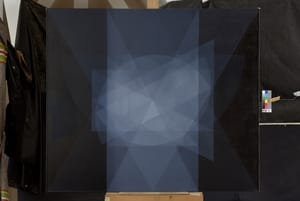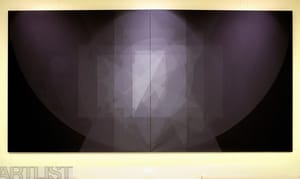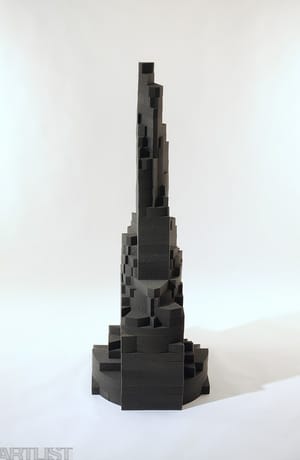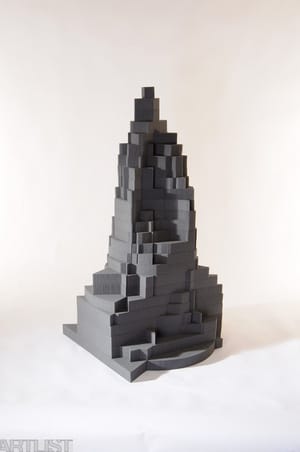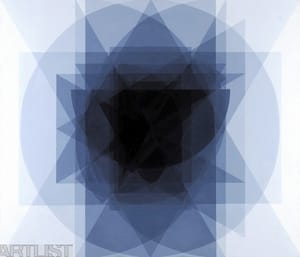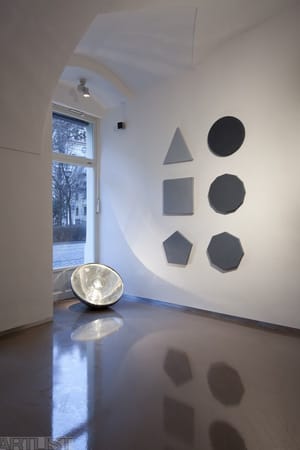- First Name
- Josef
- Surname
- Mladějovský
- Born
- 1986
- Birth place
- Frýdek-Místek
- Place of work
- Ostrava
- Website
- http://mladejovsky.blogspot.cz/
- Keywords
- CSU Library
- ↳ Find in the catalogue
About artist
The early work of Josef Mladějovský points to the development of a highly gifted colourist (e.g. Bolavé pařezy / Aching Stumps, 2008). He studied at the František Kowolowský painting studio at the Faculty of Art, Ostrava University, but opted to expand his horizons beyond those of the simply painterly, instead examining its relationships and references to modernist abstraction. These new themes required new means of expression. Instead of freely applied colour stains he moved towards a primarily conceptual treatment of coloured surfaces in order to objectivise his style and indulge his taste for irony. He himself defines the basic theme as the possibility and ability to depict “truth” by means of a non-mimetically and non-illustratively conceived painting. He reduced his colour palette and simplified the semantic system of geometric forms. The definition of the forms selected and their identification with different types and means of expression and the labelling of many different utterances as “true” converges with the precision of modernist geometric abstraction as conceived of by, for instance, Kazimir Malevich in his supremacist art. After graduation, Mladějovský returned to Malevich, paraphrasing him, quoting him, but also interrogating him and belittling the messianic ethos of his supremacist aesthetic. The problematisation of the relationship between truth and art leads Mladějovský to a more and more complex, structured and constricted style in which the strict austerity of geometric language as expressed in the cycle Žebříček hodnot / Ranking of Values undergoes complex layering and in places approaches op-art values (the series Monoscopes, 2011). In the paintings of this time he investigates one of the many paradoxes linked with the specific nature of viewing an image and asks whether it is possible to read a painting in a similar way to the way we read beautiful literature. In other words, whether the symbolic system of fine art is the same, with the same semantic rules, as that of literature. He addresses the same problems as, for instance, Miroslav Petříček, when he says that there is one basic difference between image and text, even though both share the same basic truth, and that is that while we perceive the text in individual sequences within the framework of syntactical rules of arranged words, we do not read the message in an image gradually but see it immediately from the start and simultaneously. This means that synchronicity is fundamental to the perception of the meaning of an image. Meaning does not unfold along the temporal axis but is present fully and completely in a given moment. Instead of reading it might be more appropriate to speak of “beholding”. Mladějovský attempts to connect both these methods in a concept of excavation of meaning. He simplifies as much as possible the clause or message, i.e. the individual letters from which the message is formed by geometric stylisation. He does not place these simplified letters next to each other on the canvas in a conventional textual message, but layers them on top of one another. The text therefore remains (under certain circumstances) legible, but a new value enters into its hermetic content, namely visual attractiveness. The content of the message predicts the future form of the visual depiction. The paintings created in this way represent the artist’s original attempt to deal with differing semiotic paradoxes that result in an endeavour to understand and define the visual through the relationship of the depicting and depicted. Layering as conceived of above is then used in foam-rubber reliefs, semantic ziggurats, in whose verticalised matter, closed within itself and inaccessible, is concealed the (non)decipherable meaning.
The series of wooden reliefs presented at the exhibition Supremacist Explosion documents a further shift in Mladějovský’s work. The arrangement of individual geometric elements on an insinuated canvas background again quotes selected colour abstract compositions of Maleviče. The motif of the cross is crucial to the selection. A symbol for the most part laden with a range of symbolic connotations is used here as a kind of persiflage of its original symbolic content and does not play any kind of mystical role. It becomes that which it remains first and foremost in the sphere of painting. In connection with the obverse side of the image (which is present here) the cross as part of the blind frame is a utilitarian, supporting structure allowing for the tightening of the canvas. That which in the case of the canvas-painting is usually concealed, blind, invisible and contentless now assumes pride of place in a different explicit role and becomes a new, central message. Though these are almost monochrome reliefs Mladějovský includes the colour in them that Malevič worked with. We are again witness to role reversal – colour as a hitherto basic part of all painted pictures is transformed and becomes, by virtue of its saturation and lightness, a factual limit determining the height or depth of the individual wooden elements used. Not the frame and its cross, not the obverse side, but along with the implied upper surface image colour becomes blind and invisible yet present materially.
In the oft-ploughed sphere of abstract art and the forever repeating references to its bases and principles, Mladějovský has managed to reveal a host of other possible ways of working with geometric morphology and avoiding cheap aestheticisation.
- Author of the annotation
- Martin Mikolášek
- Published
- 2015
CV
2005–2010
Faculty of Arts, University of Ostrava, Department of Painting (MGA. Francis Kowolowski)
2001–2005
Secondary Art School in Ostrava
Scholarships, awards, grants
2011
Nominations for the 2011 prize Sovereign Prize 2011
3rd place on the IV. Critics´s Prize for Young Painters
2010
Studio Award for dissertation
2009
Studio prize
Exhibitions
- Solo exhibitions
-
2015
Suprematický výprask, Galerie Dole Ostrava
2014
Žebříček hodnot, Divadlo Antonína Dvořáka, Ostrava
Jsi tak namakaný, že se nevejdeš do dveří, Galerie G99, Dům umění města Brna
2013
Ona je to taková utopická estetika, Letohrádek Ostrov, Ostrov u Karlových Varů, Galerie umění Karlovy Vary
2012
Komplexcity, Galerie OFF/Formát, Brno
Obrazová totalita, Galerie Beseda, Ostrava
2011
Materiál (s Jurajem Jakubčiakem), Galerie Kruh, Ostrava
2010
Má každý svou pravdu?, Galerie Jáma 10, Ostrava
Bodliny & plocha, Galerie ve Vile, Kopřivnice
Vnitřní nutnost, Knihovna města Ostravy, Ostrava
2009
Nová krajina, Galerie Hukvaldy, Hukvaldy
Akademici, kavárna Academia, Ostrava
2005–2006
Nekonečná výstava, Color Café, Ostrava
2004
Bez názvu, Antikvariát, Galerie Pod svícnem, Frýdek-Místek
2003
Nenáhodná setkání, galerie SUŠI, Ostrava
- Group exhibitions not included in ARTLIST.
-
2014
Metaplay II., Galerie kritiků, Praha
2013
Kukačka 2013, Ostrava
2012
Metaplay, Galerie kritiků, Praha
VI. Zlínský salon mladých, Krajská galerie výtvarného umění ve Zlíně
Art Praque, Výstavní síň Mánes, Praha
Kvalitář, Galerie Kvalitář, Praha
2011
Antitéze malby, Galerie kritiků, Praha
ARTBANKA, Galerie hlavního města (Start up), Praha
KICK OFF, Dvorak Sec Gallery, Praha
Fundamenty sedimenty, Galerie hlavního města, Praha
4. ročník Ceny kritiky, Galerie kritiků, Praha
2010
EDICE 5, Galerie Sýpka, Valašské Meziříčí
Pod Jezevčí skálou, NOD, Praha
Hody, Národní divadlo - Reduta, Brno
Ostravský polibek, (A)VOID Gallery, Praha
Diplomky 2010, Galerie výtvarného umění, Ostrava
Next wave, Galerie G99, Brno
Master Quest, Galerie Dvanáctka, Zlín
2009
Krajina malby, Galerie Dole, Ostrava
Ostrava?, Výstaviště Černá louka – Pavilon A, Ostrava
Malba II², Galerie Gaudeamus, Vítkov
Letní klauzurní práce, Malba II, Galerie Student, Ostrava
Twenties, Výbor regionů, Brusel
2008
Pall mall, Galerie Albertovec, Albertovec
2007
Jen tak na okraj, Galerie M. Zezuly, Městské divadlo, Brno
2006
Pupečník, výstava žáků IPUS, Důl Michal, Ostrava
2005
Top Topic End, Galerie Jaroslava Němce, Ostrava
Top Topic Band, Color Cafe, Ostrava
2004
Top Topic Band, Antikvariát, Frýdek-Místek
Monography
- Monography
MLADĚJOVSKÝ, Josef a KOWOLOWSKI, František. Josef Mladějovský. Jsi tak namakaný, že se nevejdeš do dveří. Brno: Dům umění města Brna, 2014. 1 složený list.
Josef Mladějovský: komplexcity: Galerie Off/Format Brno. [Brno: Galerie OFF/FORMAT, 2011?]. [5] s.
GALERIE KRITIKŮ a ČIHÁKOVÁ-NOSHIRO, Vlasta. Antitéze malby = Antithesis of painting. Praha: Galerie kritiků, 2011. [28] s
BÍLKOVÁ, Zdeňka. Josef Mladějovský: Galerie umění Karlovy Vary, 25.4.2012-30.6.2013. Karlovy Vary: Galerie umění Karlovy Vary, 2013. 1 skládanka [8] s
NAVRÁTIL, Ondřej. Josef Mladějovský Komplexcity. 18.4. - 30.5. 2012 Galerie OFF/FORMAT Brno. 2012
Vaňous, Petr, 1975-. Fundamenty & sedimenty : vzpoura hraček 2011 : Galerie hlavního města Prahy, Městská knihovna 2/2-1/5/2011 = Fundaments & sediments : toys' mutiny, 2011 : City Gallery Prague, Municipal Library. [texty Petr Vaňous ; anglický překlad Ivan Vomáčka], Galerie hlavního města Prahy. Vyd. 1. Praha : Galerie hlavního města Prahy, 2011. [64] s. : .
Hajdyla, Petr, 1985-. Petr Hajdyla a Josef Mladějovský : krajina malby : Galerie Dole Ostrava, 27.7. - 4.9.2009 : [text Martin Mikolášek]. Ostrava : Galerie Dole, 2009. [2] s.
- Articles
MIKOLÁŠEK, Martin: Současná ostravská malba. Josef Mladějovský a Martin Froulík zůstávají. Krásná Ostrava 2/2012, s. 29-30
VALOCH, Jiří: Originální posun konceptu Josefa Mladějovského. Flash Art 25/2012
VALOCH, Jiří: Suprematická geometrie Josefa Mladějovského. Prostor Zlín, 4/2011, s. 34-35
VAŇOUS, Petr: Teze a antiteze, Revolver revue 81/2010, s. 68-71
Mladějovský [online]. [Frýdek-Místek]: Josef Mladějovský, [2003?]- [cit. 2015-05-26]. Dostupné z: mladejovsky.blogspot.cz.


